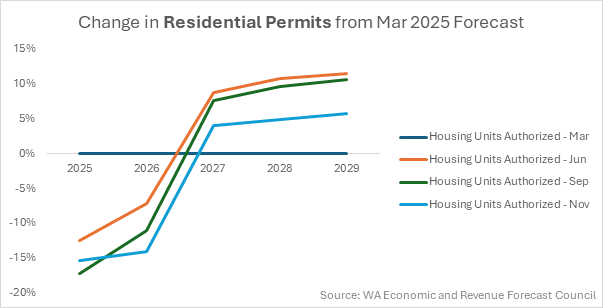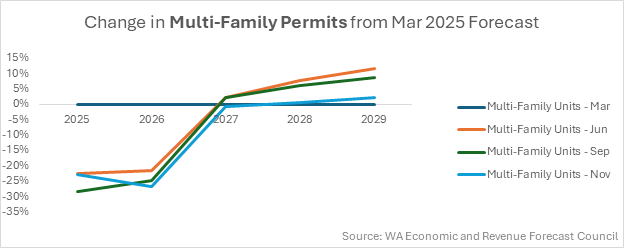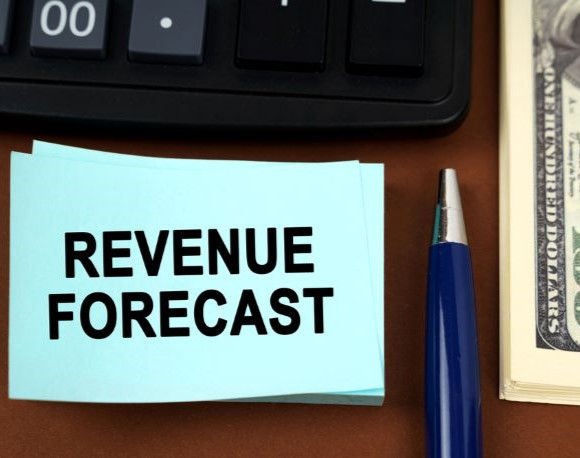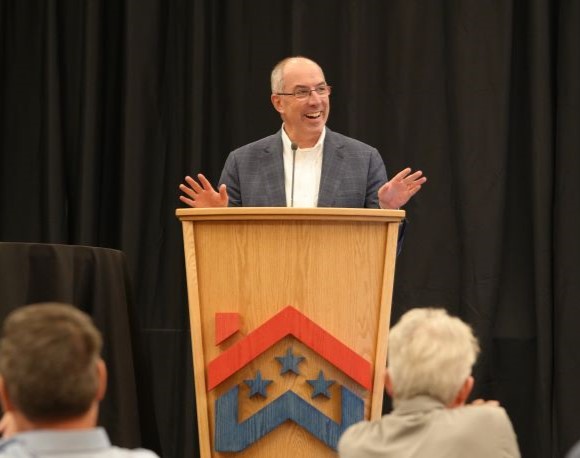November 24, 2025
The latest economic and revenue forecast for Washington state shows a deepening slump for residential building. The November forecast also shows another dip in revenue over the next four years, totaling about $970 million. This means legislators will likely face a deficit when crafting the 2026 supplemental budget next session.
The changes between forecasts can be better understood when compared to the March 2025 forecast, which is what informed legislators when crafting the 2025-27 biennial budget this year. The Washington Economic and Revenue Forecast Council creates quarterly forecasts (for the WA fiscal year starting on July 1) that serve both the executive and legislative branches.
Updated projections show residential construction is up slightly for the 2025 calendar year from the September forecast, but it remains far below the original March projection. (Figure 1)

Things are expected to get worse in 2026 before slightly rebounding above March projections in 2027 and beyond. This contributes to lower projections for revenue from permit fees as well as real estate excise, business & operation and sales taxes. Based on the most recent November forecast, the state expects an average of 36,258 residential housing units to be authorized each year between 2025 and 2029. A 2023 Department of Commerce report estimated that Washington needs more than 50,000 new residential units annually to keep pace with population growth.
Breaking down those residential construction projections shows that single-family units are expected to have a 7.38% reduction in 2025 from the March forecast. (Figure 2) Then single-family units will rebound and grow from 2026 to 2029. However, these are only units authorized by permits, and not all permits end up being built.

Most of the drop in residential construction projects is driven by multi-family development. The November forecast has multi-family development up from the September forecast in line with the June forecast. However, this was still 22.73% below the March forecast. Then the November forecast paints an even tougher picture for multi-family development with authorized units dropping in 2026 and barely reaching the original projections in March for 2027 and beyond. (Figure 3)

It is important to note that these worrying projections for residential construction are factoring in decreasing interest rates for 30-year fixed mortgages. (Figure 4) While interest rates are important in the development, construction, and sale of new housing units, there are other factors that affect the housing sector. Lowered interest rates can spur housing demand and construction. With the projections showing a particularly tough situation for multi-family development, the Legislature should put a continued focus on reducing barriers and lowering costs for multi-family residential construction.

Forecasts since March show overall revenue growth coming from the largest tax increase in Washington state history, passed by the Legislature earlier this year. However, each subsequent forecast lowered the amount of growth expected. Because the March forecast is used by legislators to draft the state's budget and tax increases, the June forecast better reflects what they would have expected in terms of revenue growth. The November forecast has revenue going up slightly for the current biennium. But the overall revenue outlook over four years is worse. This means that overall revenue is projected to be about $970 million lower than expected from June.
The $970 million revenue drop will likely contribute to a deficit facing Governor Ferguson and the Legislature as they seek to create a supplementary budget for 2026. The government should always explore ways to reduce inefficiencies and unnecessary spending, but lawmakers are already discussing additional tax proposals to balance the budget.
It’s clear that the massive tax increases passed this year are not producing the desired revenue increases. In fact, it’s likely they are contributing to reduced economic activity. The Legislature should consider ways to support the economy and restore confidence in the state’s business environment. Supporting growth in housing production will not only help address our housing affordability crisis but also help generate more revenue for the state. That’s a win-win for Washingtonians.







.jpg)
